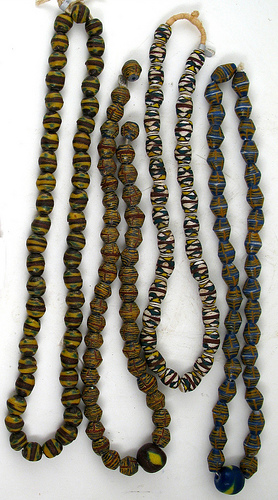Everyone knows that old Venetian trade beads carry a certain worth depending on age, but are you aware that some types of African recycled Glass Beads are also highly collectible? Scarcity is one of the key factors which influences the value of recycled glass beads, however, age and composition can also increase their monetary worth.

The earliest known recycled glass beads made in Africa were produced long before glass-making technology was introduced. From as early as the 18th Century, the Ashanti tribe of Ghana were recycling old and broken trade beads to create new ones for self adornment and trade. These came to be known as “Bodom” beads, and were distinguishable from most types of trade beads because they were larger and more primitive in design. Early Bodom beads were typically yellow with a dark gray or black central core. The outer skin featured trailed stripes or a cruciform design, not dissimilar to French Cross Beads which found their way into Africa in the mid 19th Century. Bodom beads were considered among the most valuable beads in Ghana. So much so, in fact, that it is said one bead could buy as many as seven slaves!
Ateyun beads are another form of recycled glass bead produced in Africa prior to the introduction of glass-making. The resourceful Yoruba of Nigeria began to produce them in the late 19th Century as the supply of coral beads from the North began to dwindle. Early Ateyun beads were modelled using the fragments of old trade beads brought over from Europe, and were made to look just like the blue coral found off Africa’s Gold Coast. Early Ateyun beads are scarce and expensive, with strands going for as much as $300 in the US.